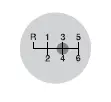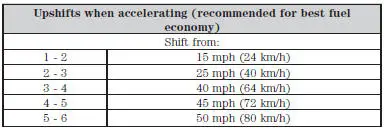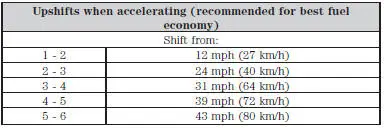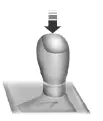Ford Mustang (2005-2014) Owners Manual: Manual transmission
Using the Clutch
Manual transmission vehicles have a starter interlock that prevents starting the engine unless the clutch pedal is fully pressed.
To start the vehicle: 1. Make sure the parking brake is fully set.

2. Press the clutch pedal to the
floor, then put the gearshift lever in
the neutral position.
3. Start the engine.
4. Press the brake pedal and move
the gearshift lever to the desired
gear; position 1 or position R .
5. Release the parking brake, then
slowly release the clutch pedal
while slowly pressing on the
accelerator.
During each shift, the clutch pedal must be fully pressed to the floor.
Make sure the floor mat is properly positioned so it does not interfere with the full extension of the clutch pedal.
Note: Failure to fully press the clutch pedal to the floor may cause increased shift efforts, prematurely wear transmission components or damage the transmission.
Note: Do not drive with your foot resting on the clutch pedal or use the clutch pedal to hold your vehicle at a standstill while waiting on a hill.
These actions will reduce the life of the clutch and could nullify a clutch warranty claim.
Recommended Shift Speeds
Note: Do not downshift into position 1 when your vehicle is moving faster than 15 mph (24 km/h). This may damage the clutch or transmission.
Upshift according to the following charts.
For the 3.7L V6 with 2.73 axle ratio, shift according to the following chart:

For the 3.7L V6 with 3.31 axle ratio, shift according to the following chart:

For the 5.0L V8, shift according to the following chart:

Reverse
Note: The gearshift lever can only be moved to position R by pushing the knob down before shifting to reverse. This is a lockout feature which protects the transmission from accidentally engaging position R when intending to select position 1.
1. Make sure that your vehicle is at a complete stop before you shift into
position R . Failure to do so may damage the transmission.
2. Press the clutch pedal to the floor to disengage clutch.

3. Shift into position R by pushing the gearshift knob down, then moving the lever fully to the left, then forward.
Note: Do not press down on the shifter during any operation other than shifting to position R, as you may be inhibited from selecting your desired gear.
If position R is not fully engaged, press the clutch pedal down and return the gearshift to the neutral position. Release the clutch pedal for a moment, then press it down and shift to position R again.
Parking Your Vehicle
WARNING: Do not park your vehicle in Neutral, it may move unexpectedly and injure someone. Use 1 (First) gear and set the parking brake fully.
To park your vehicle:
1. Apply the brake and shift into the neutral position.
2. Fully apply the parking brake, hold the clutch pedal down, then shift
into position 1.
3. Turn the ignition off.
 Automatic transmission
Automatic transmission
WARNING: Always set the parking brake fully and make sure
the gearshift is latched in position P. Turn the ignition off and
remove the key whenever you leave your vehicle.
Your vehicle has been design ...
 Axle information
Axle information
Traction-Lok™ Axle (If Equipped)
This axle provides added traction on slippery surfaces, particularly when
one wheel is on a poor traction surface. Under normal conditions, the
Traction-Lok™ axle ...
Other materials:
Interior luggage compartment release
WARNING: Keep vehicle doors and luggage compartment locked
and keep keys and remote transmitters out of a child’s reach.
Unsupervised children could lock themselves in the trunk and risk
injury. Children should be taught not to play in vehicles.
WARNING: Do ...
Leakage Inspection
CAUTION: Do not try to stop the fluid leak by increasing the torque
beyond specifications.
This may cause damage to the case threads.
Check the fluid filler tube connection at the transmission case. If
leakage is found here, install a new
grommet.
Ch ...
Creating a MyKey
Use the information display to create a MyKey.
For Type 1 information displays:
1. Insert the key you want to program into the ignition.
2. Switch the ignition on.
3. Access the main menu within the information display, and press
SETUP using the information d ...
